How to install a package of bees in a hive?
HOW TO INSTALL BEES IN A HIVE
Bees by the pound are usually shipped by railway express. The cage in which they are transported is called a package. This container has a very simple construction. It is an oblong cage. The top and bottom is made of thin wood, separated and supported at the outside corners by thin posts, and it is braced on the inside with slats. The open sides are enclosed with wire cloth. The bees are shaken into this receptacle, through a hole in the top board.A breeder who sells bees by the pound maintains thousands of hives which contain frames with comb, covered with bees. His ultimate product is bees rather than honey. As he makes his rounds of inspection he does not mark progress in honey content, but notes rather whether the day has yielded a good crop of grub. He shakes bees from the combs into a funnel, leaving some, however, to nurse and rear the grub, for that is his next crop. The content of the funnel is then transferred to a package.
A package can conveniently accomodate from one to five pounds of bees. Some beekeepers, with hundreds of hives, requiring hundreds of packages, prefer to call for their own purchases. However, most breeders for the package trade are located several days’ journey from their buyers; and personal delivery of the average small order is not practical. Hence bees are usually shipped by express.
Can you feed bees too much sugar water
A system of feeding en route has been devised. Each package is stocked with a tin can of sugar water, sufficient for the journey. The sugar can is used as a cork for the upper board of the cage and the rim is a support for the upper end of the can, while the lower end rests against the slats which brace the inside of the cage. The sugar water drips through two or three Ismail holes and is picked up by the bees which cluster about it.The queen, if you buy a package with queen, travels in her own private cage accompanied by a small retinue. This cage is inserted into the package alongside the sugar can, and is secured against lurching and the crushing of bees in the same manner as is the sugar can.
Prompt delivery is important. Delay is bad; if it has been a long trip, the bees will be hot, tired, and even hungry. Ten thousand bees awaiting a turn for a sip of sugar water from a few holes in a tin can, and constantly jostled, and with air frequently cut off by other freight, do not reach their destination in good humor. You will be greeted with a package of angry, buzzing bees.
First put the package in the shade, and if possible in the line of a light breeze. Feed a solution of half sugar in warm water. Paint this across all sides of the wire cloth with a soft brush or rag. In fact, gorge the bees with it. The angry tones will then soften to a pleasant hum, and soon quiet and peace will reign.
They are now ready for the hive. Keep them in that mood with repeated feedings. Stuff them till sundown which is the best hour for installation.
There are various methods for putting packages of bees into hives and spokesmen for and against each. There are methods that have been used and abandoned and forgotten until they were advocated again by some newcomer as his contribution to apiculture. Space does not permit a full discussion of the various methods for hiving packages. If you have one of your own, and like it, use it.
Whatever the method, you must first prepare the hive. Limit it in size to the needs of your new colony. A three-pound package with ten thousand bees should not be hived into a structure large enough to accommodate fifty thousand. Cut it down to the bottom board, one hive body, entrance cleat at its smallest, five frames with foundation, inner cover and outer cover. A three-pound package, starting life in anything bigger, would become bewildered and spread over an area they could never manage effectively.
The beginner who is afraid of bees will find their installation an ordeal. First he should thoroughly gorge them with sugar syrup and then spray (not drown) them with the same substance. Bees with sticky wings cannot fly, nor send forth that buzz that chills the amateur. The best or worst they can do is crawl. Open the hive and place the outer and inner cover where they are easily available. Remove the sugar can and queen cage from the package. They lift out easily. Merely remove the wooden cap; tip the cage over slightly till the sugar-can slips out far enough to get a grip on it. Then draw it out gently! Shake the bees out of the package and into the hive. Spray the queen and shake her on top of them. Be gentle, by all means. Cover the hive and close up the entrance until late the next morning. That is called the Spray and Direct Release Method, and it was developed at the Division of Bee Culture of the U. S. Department of Agriculture. The mass of sugar-soaked bees on the bottom-board crawl up onto the combs, and the work of the hive begins. Three days later replace the frames and foundation that were removed in preparing the hive for installation. You are now a beekeeper.
The next method of hiving bees, or some personal modification of it, is the one used generally by beekeepers. It does not call for spraying, and accordingly it saves sugar to that extent, and eliminates a messy job. Remove the sugar can as illustrated. After a long trip it is empty, or nearly so, and may be discarded. If there are bees on it shake them into the hive. Place the package into the hive body, top side up or (alternative) invert it over the frames, top side down.
Remove the queen cage from the package. There is an exit at one end of this cage stuffed with sugar candy, and covered with either tin or cardboard. Whatever the covering remove it, and gently run a nail through the center of the sugar-candy, but not into the queen on the other side of it. Then withdraw the nail. Hang the queen cage between two frames, exit hole up. Any method of suspending it is satisfactory. Some beekeepers hold it in place merely by the pressure of the two frames between which it is suspended. I push a tack or nail into each side of the cage, and then suspend it between the frames by these nails, exit hole up.
Or (alternative) lay the queen cage on top of the frames, wire side down. Or (alternative) lay the queen cage on the bottom board and under the frames, wire side up. Close up the hive. Reduce the entrance cleat to its smallest opening.
Do not disturb for at least three days. On the fourth, or fifth day, if you I have the control to wait, reopen the hive; remove the empty package and replace the frames and foundation you withdrew preparatory to installation. Examine the queen cage. If the sugar candy blocking the exit has been eaten through by the bees, and the queen thereby released, then also remove the cage. Your hive is moving ahead now.
How to Install Bees Into a Beehive
Feeding
It has been learned from experience that a package must be fed the first week. The menu is a syrup of half sugar and half warm water. This prevents starvation, and stimulates the drawing of comb.There are many types of feeding equipment. A simple form is an open pan filled with syrup. Place it in the hive, on top of the frames. Float pieces of cork in it, as a feeding platform. This method is now outmoded. I mention it for emergencies when no other equipment is available. The chief objection is that the rate of feeding cannot be regulated. The bees eat fast and gorge, and the unnatural resultant strain on the digestive tract kills many. Further, the unexpected appearance of food in plenty causes great excitement. Bees in the general neighborhood are attracted, and like the general busybodies that they are, they join the jamboree. Some beekeepers call it robbing rather than sociability. When the supply of syrup has been thus quickly expended, the bees turn cross and attack anything in sight; it may be the clothes pole, or the swaying laundry, and most impressive of all, it may be you.
A method has been devised that regulates feeding. The syrup is put into a closed container, usually a tin pail (5 or 10 lb. size) or a glass mason jar, with a metal cover, with small holes punched through it. When this container is inverted, the bees obtain the syrup but only through the holes in the lid, and the amount obtainable in that limited way can be further controlled and regulated by the size and number of holes. This system is called the Friction top Pail Feeder. It can be placed either in the hive, inverted and resting on top of the frames or else in front of the hive, on the bottom board in a so called Entrance Feeder. The Entrance Feeder Method does not call for opening the hive, either to insert or renew the food, is always in open view, and the beekeeper can readily note the extent to which it has been emptied. At the end of a week your colony should be on its way to self-support. You will then observe how the bees develop, and their cycle of life.



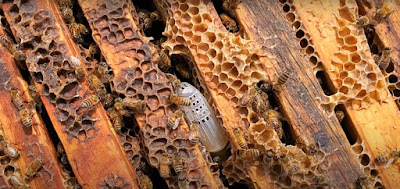
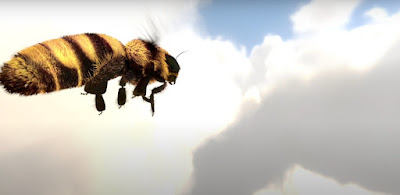

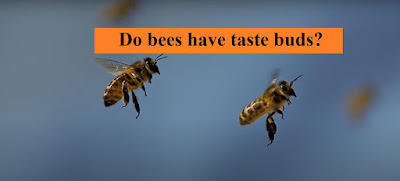
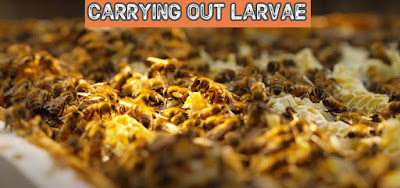
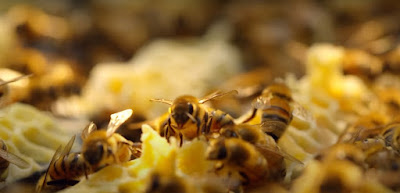

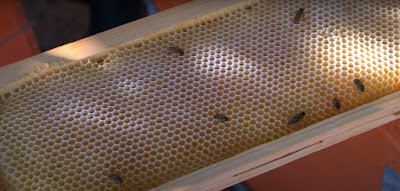


Comments
Post a Comment